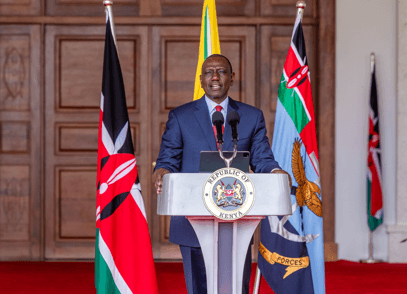The human race has been classified into agricultural farmers and herders over the years. The Agrarian Revolution led to the industrial revolution and sometimes we tend to think of these changes only in terms of farming but pastoralism has also been evolving albeit with lots of challenges. If done well and attended to by State and non-state actors, pastoralism can be profitable as it is a tried and tested means of livelihood for human beings.
In Kenya, several communities especially those in arid and semi-arid areas earn their living from livestock keeping. Since this requires large land areas, most of these communities’ straddle county borders and national boundaries. This is the case for the Maasai and Kalenjin communities on the Kenya-Uganda border. The Somalis are on the Kenya-Somalia border, the Borana Gabra and Garre on the Kenya-Ethiopia border, the Turkana and Toposa along the Kenya South Sudan border and the Turkana, Pokot and Karamojong communities along the Kenya Uganda border.
Livestock keeping, which largely depends on vast drylands, presents a myriad of challenges to the pastoral communities. The twin challenges of conflict and climate risks pose significant challenges as climate change affects rising land temperatures, frequent droughts, reduced rainfall, and flash floods, all impacting community livelihoods. Pastoralist communities in Eastern Africa face more demands on their way of life today than at any other time.
Population growth, loss of grazing land to farmers, ranchers, game parks and urban growth are driving away herders and undermining their way of living; there’s increased commoditisation of the livestock economy, nomadism and dislocation brought about by drought, famine and lack of space. What’s needed is a civil structured way to address these challenges faced by the pastoralist communities.
Pastoralists’ capacities for resilience and sustainable livelihoods are more often than not reduced due to environmental factors and all efforts towards climate change management have to be doubled by local and international actors to ensure our brothers and sisters in these harsh environments can also survive.
Development programme amongst the cross-border communities have to embrace policies and development interventions that reduce risks, diminish livelihood constraints, and expand opportunities for increased household resilience to drought. These are critical complements to the pastoralists’ coping strategies.
IGAD for instance has initiated regional policy formulation dialogue, cooperation and harmonisation especially on interventions related to sharing of resources, climate adaptation, cross-clusters trade concerns, and strengthened transformative capacities for sustainability. IGAD member states have ratified numerous cross-border protocols, policies, and agreements over the years but there is limited awareness of the existence of these regional protocols, agreements, and policies.
Land policy
Land Policy Land is a key factor of production because it provides the foundation for all activities such as agriculture, water, settlement, tourism, wildlife, forestry, and infrastructure and hence important to the social, economic, and political development of a nation. Member states therefore need to better management land including integrating land, water, biodiversity, and environmental management to meet rising food demands while sustaining ecosystem services and livelihoods. The policy describes knowledge-based procedures for preserving and enhancing the productive capabilities of land and actions to stop and reverse degradation. It generally guides on management of land use across the member states.
Rangeland management policy
The social, cultural, ecological, and economic importance of rangelands transcend national boundaries. Therefore, sustainable management of rangelands in the IGAD region requires a regional strategic framework that is cognisant of the shared rangeland resources, interconnectedness of issues and shared responsibilities amongst the countries and communities. The strategic framework is therefore particularly required to address the problem of weak linkages and coordination of policies on rangeland development and actions by stakeholders.
Transhumance protocol
The transhumance protocol in the IGAD region is premised on the understanding that migration in search of pasture and water is paramount to the very survival of transhumant pastoralist communities. The protocol contextualises the continent-wide AU policy framework on pastoralism, adopted in January 2021 with special focus on cross border mobility.
Eastern Africa Livestock Feed and Feeding Strategy (2023-37)
The strategy aims to promote and highlight the crucial roles that adequate and quality animal feed and balanced animal nutrition play in achieving sustainable livestock production that; supports income generation, employment creation and good human nutrition. The strategy also seeks to enhances resilience of livestock producers and other actors to climate vagaries in Eastern Africa. The strategy envisions ‘a vibrant and flourishing animal feed sector in Eastern Africa that adequately, efficiently and sustainably supports the livestock sector in delivering products and services for human population.’ The policy therefore provides a framework for various animal feed types, feeding roadmaps and interventions that help to achieve the common goal of a highly productive, sustainable and resilient livestock sector, that improves community and household livelihoods and wealth, food security and nutrition, and social wellbeing of citizens, and that contributes to job creation.
Strategy for sustainable and resilient livestock development
The strategy is a holistic and comprehensive plan designed to build a livestock sector resilient to the effects of climate change, while promoting simultaneous growth and sustainable development throughout the region. It reflects the existing priorities expressed in member states’ national policies, consolidating relevant priorities at the nexus of livestock sector development, climate change, and sustainability into a unified, strategic thrust. It draws upon regional and national stakeholder input as well as on extensive diagnostic work and modelling to assess the effectiveness of policy interventions aiming at improving the sector’s resilience.
The writer is a peace and media consultant, [email protected]













![[PHOTOS] Three dead, 15 injured in Mombasa Rd crash](/_next/image?url=https%3A%2F%2Fcdn.radioafrica.digital%2Fimage%2F2025%2F11%2Fa5ff4cf9-c4a2-4fd2-b64c-6cabbbf63010.jpeg&w=3840&q=100)

